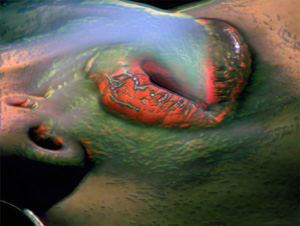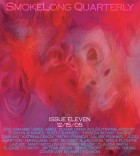Explain how El Latigo ended up in a story about a girl’s first period.
Not an easy question to answer! Whatever I read or view haunts me. Once I spent a week watching “Man with the Steel Whip,” a Republic serial from the 1950’s. Despite El Latigo’s paunch and ridiculous costume and stilted acting, he was a master of the whip, he was a hero to the townspeople. He befriended the Indians and shot bad guys. I wanted to be him.
I ride the subway with the voice of whatever writer I am reading at the time ringing in my ears, or the vistas of John Ford or Sergio Leone before my eyes. It’s a wonder I actually get to the right destination sometimes. It’s an easy step to imagine this, in the guise of the mysterious “El Latigo,” speaking up and informing a person’s actions. Young children, immersed in their imagination as they play, understand this power of inner vision. After childhood—and a girl’s first period offers the moment a very poignant threshold—nothing seems as full of meaning again. Yet, once one moves on, leaves the fantasies behind, adult life has its share of visions, too.
The story of Eden, one might argue, works as a metaphor for the expulsion out of childhood. We only get one chance for Eden. Contained in this archetypal moment is the tragedy of gaining the world and losing something unrecoverable about ourselves. What did that adolescent time mean for you?—and do you remember your own moment of expulsion? What did you leave behind?
My own adolescence was fairly typical: painful self-consciousness, bad haircuts, the unrequited wish to be noticed by boys, finally the awkwardness of dates that fell far short of reality… Yet it was a good time for writing and art. I began to have things to say, secrets to keep, a point of view, and every so often, someone to listen! Then I realized I would have to hide much of my inner life from others or risk being “un-cool.” In retrospect, that growing self-consciousness must be very much like Adam and Eve’s desire for a little fig leaf or carefully placed strands of hair. The real expulsion from Paradise was when I realized that with the onset of menses, my body had betrayed me. I was no longer a child, and as such, would be forced to “put away childish things.” The beginning of puberty is celebrated in many households; it wasn’t in mine, and I hid the fact for as long as I could. Much of the dreams and fantasies were left behind, but some remain still, inspiring me to write and paint and to seek to avoid consequences.
I grew up with (and because of) my grandfather’s love of Westerns. What attracts you to them? How can they still have relevance when there’s no West left? {I agree that they still have importance}. What are some specific ways they’ve influenced your work?
I hated Westerns as a child and wanted to be the Indian, always, and to die nobly. Now I appreciate the gear—the boots, spurs, and holster—and the elements that make up a Western. The characters and their functions can be put together in opposition or conjunction in a myriad of highly satisfying ways. Rather than groan at creaking stereotypes and plots, I love the way these arrangements can be composed and how they play out on the page or screen.
Perhaps rather than a direct relevance, Westerns have more of a resonance. There is always going to be another neo-western or anti-western or a film that is described glowingly as a “western at heart.” It’s as if people still need that kind of structure to order their perceptions of America or being American, for better or worse.
My experiences when traveling out west have contributed a great deal to my work. I am intrigued when preconceptions clash with reality, or when reality far outstrips expectations, or when my fantasy of the West matches perfectly with what I experience. Specifically, I went on one trip that had it all. Having to sleep in a hotel’s parking lot on my very first night ever in the West was a bummer. I was the most disappointing aspect to it; I couldn’t drum up the appropriate spirit of Adventure at all. Then, thunderstorms and flashfloods in the desert were literally breathtaking—yes, you could die out there. And lastly, one of the highlights of my Western travels was getting to meet Ray Boeshart, former stagecoach driver in B-westerns. I got to ride shotgun with him in his stagecoach in a tourist-trap western town. He was the Ur-cowboy, and he and these other tales have all found their way into my work.
Does teaching give you different insight into the artistic process? What has it taught you? Does it, in any way, negatively affect your own work?
I’m not sure if my insights are different from any other artist’s because of being a teacher, but I’ll describe a couple of things. Teaching a wide range of subjects to squirming, note-passing, and sometimes rapt students taught me the importance of a story arc. It’s given me insights on how people mature and the accompanying mental paradigm shifts. It’s given me patience; there is an answer or a direction to take, if I look carefully enough. Aside from taking time away from the intensely private and time-consuming practice of writing, it hasn’t negatively affected my work. I hope. I keep the lives separate.
A new year approaches (yikes!). So, what’s the best that 2005 had to offer in literature, web sites, music, movies, television, DVD, and the like? Also, any predictions for 2006? And we’d love to hear your New Year’s resolution.
I’ve been monk-like for a while, trying to balance working and writing, so my forays into movies and music have been rare. Much of my reading and viewing have been to catch up on things I had missed, from Deadwood episodes to John Rechy.
I have a few thankful blessings for 2005, however.
God Bless the fact that Hollywood saw fit to put out a movie about two cowboys who fall in love. I haven’t seen Brokeback Mountain yet, but the short story by Annie Proulx is as raw and awesome as the West truly is.
God Bless the fact that there can be a movie like Capote, which ends ambiguously. Capote probably didn’t know for sure what he felt about the killers, and it’s nice not be told exactly what he felt.
God Bless Deadwood, a series that continues to use forms of “cocksucker” as an adjective, noun, and verb. Very Western.
Predictions? Another anti-western, no doubt.
New Year Resolution? Nothing too fantastic. Write.



 The core workshop of SmokeLong Fitness is all in writing, so you can take part from anywhere at anytime. We are excited about creating a supportive, consistent and structured environment for flash writers to work on their craft in a community. We are thrilled and proud to say that our workshop participants have won, placed, or been listed in every major flash competition. Community works.
The core workshop of SmokeLong Fitness is all in writing, so you can take part from anywhere at anytime. We are excited about creating a supportive, consistent and structured environment for flash writers to work on their craft in a community. We are thrilled and proud to say that our workshop participants have won, placed, or been listed in every major flash competition. Community works.